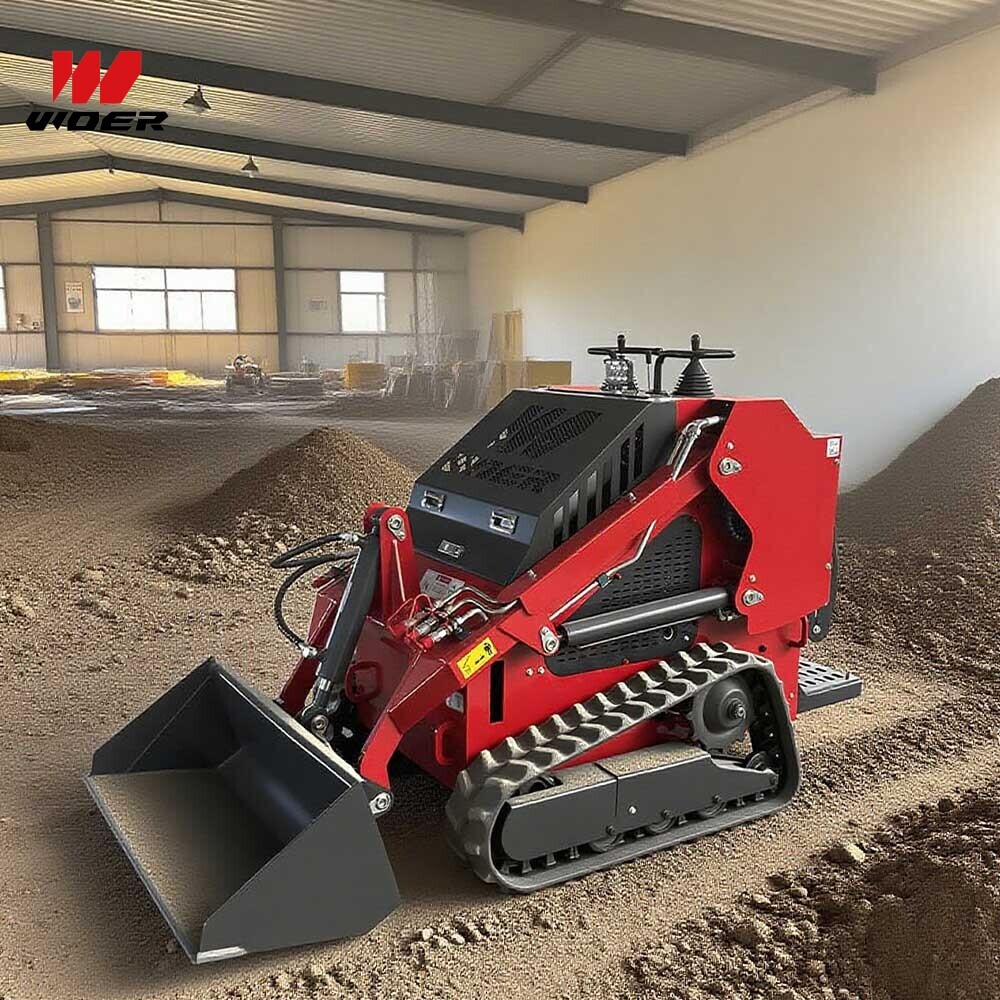Navigation
Contact us
Phone
Message

A track skid steer loader can transform forestry tasks by improving traction, flotation, and operator confidence on uneven, wet, or sensitive ground. This guide helps operators and specifiers assess whether a track or a wheeled skid loader — including mini skid steer loader options — fits their forestry needs.
Why tracks often outperform wheels in forestry
Forestry work exposes machines to mud, roots, steep slopes and soft soils. A track loader skid steer distributes load over a larger contact area than a skid loader with tires, resulting in lower ground pressure and less soil disturbance. That matters for site reclamation, trail maintenance and operations in wet seasons. Track skid steer loader designs also offer superior traction on steep or slippery slopes, reducing wheel spin and improving cycle times.
Traction, stability and flotation
Tracks increase grip on logs, rocks and packed organic surfaces. Operators report better control when loading, winching or operating a grapple. Mini loader skid steer variants are valuable where access is constrained: a mini skid loader with tracks fits narrow corridors yet preserves the flotation advantages of larger track units. For low-impact forest stewardship, a mini skid steer track loader or full-size track skid steer loader is usually the preferred choice.
Durability in abrasive conditions
Modern rubber-track undercarriages resist cuts and tears from branches and stumps better than exposed tire sidewalls, but they require attention to tension and debris prevention. Track components can be rebuilt or replaced, and many models offer modular components to simplify field service — an important factor for remote logging operations.
Track skid steer loader vs wheeled skid loader: a practical comparison
Common forestry applications and attachments
Track skid steer loader platforms support a broad range of forestry attachments: mulchers, stump grinders, brush cutters, log grapples and winches. Choosing the right hydraulic flow, auxiliary circuit and mounting geometry ensures compatibility with forestry implements. For confined site clearing, a mini skid steer loader or mini skid loader with a compact mulcher saves time while minimizing collateral damage to surrounding trees.
For operators who also process firewood onsite, complementary equipment can streamline workflow. Consider integrating a compact firewood processor into the work cycle; for example, the is an example of an accessory-grade machine that can be paired with loader logistics to increase throughput and create value-added product streams.
Technical specifications and standards to consider
Key specifications that influence forestry performance include engine power (hp), operating weight, rated operating capacity (ROC), track width, ground pressure and hydraulic flow (gpm). Look for machines that conform to recognized safety and manufacturing standards such as ROPS/FOPS, and consider compliance with EN/ISO standards relevant to hydraulic systems and emissions. Operators purchasing from international suppliers (including skid steer loader china manufacturers) should verify CE or equivalent certifications and review parts availability.
Rubber vs steel tracks
Rubber tracks provide quieter operation and protect sensitive soils; steel tracks offer longer life in highly abrasive rock or heavy-duty skidder-like work. Many forestry operations favor durable rubber tracks with steel-reinforced cores for a balance of traction and longevity.
Buying considerations: how to choose the right machine
Start by defining primary tasks: mulching, log handling, site prep or road maintenance. For predominantly off-road, soft-ground tasks, prioritize a track loader skid steer; for mixed-site work with frequent road travel, a wheeled skid loader might be more economical. Mini skid steer track loader models shine in low-clearance or trail-sensitive areas. When evaluating models, request detailed undercarriage component lists, track life estimates, warranty terms, and local parts support.
Cost and lifecycle factors
Initial cost for a track skid steer loader can be higher than an equivalent wheeled model, but lifecycle costs may favor tracks where downtime from stuck machines or terrain damage would be expensive. Include transport costs, undercarriage rebuild intervals, and resale values in your total cost of ownership (TCO) analysis.
Maintenance best practices for forestry operators
Daily inspections should include track tension, debris removal from sprockets and rollers, hydraulic hose checks and undercarriage debris cleaning. Preventive maintenance reduces unplanned downtime in remote sites. Keep service intervals aligned with manufacturer recommendations and maintain a small spare-parts kit for seals, hoses and track fasteners.
Common misconceptions and usage pitfalls
One myth is that tracks eliminate all mobility issues; they improve traction but can still be damaged by sharp stumps or hidden metal. Another misconception is that tracks always deliver lower operating costs; correct maintenance, operational discipline and mission alignment determine long-term savings. For skilled operators, a track steer can dramatically improve productivity, but inexperienced use on rock-strewn slopes can accelerate wear.
Case insight and operator experience
Midsized timber contractors often report 20–35% productivity gains when switching to track skid steer loaders for winter and spring work, citing better passability and fewer stuck-machine rescues. Smaller landowners benefit from mini loader skid steer models: they handle trail clearing and firewood prep with lower site impact and reduced fuel consumption compared to larger equipment.
Why choose us and next steps
If you need equipment tailored to forestry conditions, select a supplier that offers both product expertise and after-sales support: undercarriage service, parts availability and local technical training. We provide model comparisons, on-site consultation and support for specification matching so you choose between skid loader, track skid steer loader or mini skid loader options with confidence. Contact our team to arrange a demo or to get a customized quote and operator training plan.

This stunning beach house property is a true oasis, nestled in a serene coastal community with direct access to the beach.
Contact
West Street, Melbourne Victoria 3000 Australia